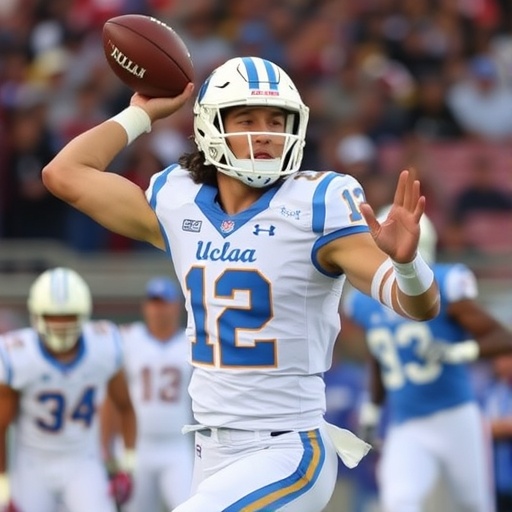UCLA Bruins Routed 56-6 by No. 2 Indiana Hoosiers: Bowl Game Hopes Dangle in Big Ten Turmoil
In a stunning display of dominance, the No. 2 Indiana Hoosiers dismantled the UCLA Bruins 56-6 in a lopsided Big Ten college football showdown that has left the Bruins’ bowl game aspirations teetering on the brink. The emphatic victory for Indiana not only solidified their status as a national title contender but exposed glaring vulnerabilities in UCLA’s roster, raising urgent questions about their postseason viability just midway through the season.
- Hoosiers’ Blitzkrieg: Indiana’s Offense Overwhelms in Opening Salvo
- Bruins’ Backfield Breakdown: Defensive Collapse Seals Fate
- Stifled Attack: UCLA’s Offense Fizzles Against Hoosier Defense
- Standout Stars and Costly Errors: Moments That Defined the Debacle
- Salvaging the Season: UCLA’s Daunting Road to Bowl Eligibility
The game, played under the lights at Memorial Stadium in Bloomington, Indiana, unfolded as a nightmare for UCLA head coach DeShaun Foster. What started as a competitive opening drive quickly spiraled into a rout, with the Hoosiers amassing 28 points in the first half alone. This defeat marks the most lopsided loss for the Bruins since their 2018 drubbing by Notre Dame, dropping their record to 3-4 overall and 1-3 in Big Ten play. For Indiana, now 8-0 and riding a wave of momentum, the win propels them closer to a College Football Playoff berth.
Defensive lapses were rampant for UCLA, as the Hoosiers’ explosive offense racked up 512 total yards, including 285 on the ground. Offensive struggles compounded the misery, with the Bruins managing just 142 yards and turning the ball over three times. As the scoreboard widened, so did the gap between UCLA’s preseason expectations and their harsh reality in the unforgiving Big Ten landscape.
Hoosiers’ Blitzkrieg: Indiana’s Offense Overwhelms in Opening Salvo
From the opening whistle, the Indiana Hoosiers set the tone with a precision offensive attack that left the UCLA Bruins reeling. Quarterback Kurtis Rourke, the Big Ten’s leading passer, orchestrated a masterclass, completing 22 of 28 passes for 312 yards and four touchdowns. His connections with wide receiver Donaven McCulley, who hauled in two scores, sliced through UCLA’s secondary like a hot knife through butter.
The first quarter alone saw Indiana strike twice: a 45-yard touchdown pass to McCulley on their opening drive and a 12-yard rushing score by running back Justice Ellison just minutes later. By halftime, the Hoosiers led 28-0, having converted 7 of 9 third-down attempts. “We came out with fire in our bellies,” Rourke said post-game. “This team’s been building for moments like this all season.”
For UCLA, the early deficit was a harbinger of defensive woes. Their front seven, expected to be a strength after offseason reinforcements, failed to generate pressure on Rourke, who was sacked only once. Linebacker Kain Medrano, a preseason All-Big Ten selection, recorded just three tackles, a far cry from his projected impact. The Hoosiers’ no-huddle tempo exacerbated the Bruins’ substitution errors, leading to two offside penalties that extended Indiana’s drives.
Statistically, Indiana’s first-half dominance was eye-popping: 245 yards of total offense compared to UCLA’s meager 48. This offensive explosion not only padded the score but highlighted Indiana’s evolution under head coach Curt Cignetti, who has transformed the Hoosiers from a perennial also-ran into a Big Ten powerhouse. Their balanced attack—189 rushing yards in the first half—kept UCLA’s defense guessing, a tactic that has become the Hoosiers’ signature in their undefeated campaign.
Bruins’ Backfield Breakdown: Defensive Collapse Seals Fate
As the game progressed into the second half, UCLA’s defense, already battered, completely unraveled against the relentless Indiana Hoosiers. What was billed as a gritty Big Ten battle devolved into a 50-point thrashing, with the Hoosiers adding 28 more points after intermission. The Bruins’ secondary, plagued by miscommunications, allowed three long passes over 30 yards, each resulting in touchdowns.
Cornerback John Johnson III, a transfer from Ohio State, was torched for 142 yards and two scores, underscoring the integration challenges in UCLA’s revamped defense. “We didn’t execute our assignments,” admitted defensive coordinator Ikaika Malloe. “Against a team like Indiana, you can’t afford those mistakes.” The Hoosiers capitalized on these lapses, with running back Jaylin Lucas breaking free for a 68-yard touchdown run that ignited the Memorial Stadium crowd.
Turnovers further doomed UCLA, as two interceptions by safety Bryan Addison—both on tipped passes—shifted momentum decisively. Indiana’s special teams also shone, blocking a Bruins’ punt and returning it 22 yards for a score. In total, UCLA’s defense surrendered 512 yards, the most in program history against a ranked opponent. This performance drops their national ranking in total defense from No. 45 to a dismal No. 112, a stark indicator of their bowl game jeopardy.
Contextually, this loss fits a troubling pattern for UCLA in Big Ten play. Since joining the conference in 2024, the Bruins have struggled against top-tier offenses, posting a 1-5 record against ranked teams. Indiana’s physicality at the line of scrimmage—outgaining UCLA 285-67 in rushing—exposed the Bruins’ lack of depth, with key lineman Garrett DiGiorgio exiting early with a hamstring strain.
Stifled Attack: UCLA’s Offense Fizzles Against Hoosier Defense
While the defense bore the brunt of the blame, UCLA’s offense offered little resistance in their 56-6 rout by the Indiana Hoosiers. Quarterback Ethan Garbers, starting his seventh straight game, completed just 14 of 32 passes for 98 yards, with one interception and no touchdowns. The Bruins’ ground game fared even worse, managing only 44 yards on 18 carries, averaging a paltry 2.4 yards per attempt.
Indiana’s defense, led by All-American linebacker Aaron Graves, swarmed Garbers from the outset, sacking him five times and forcing two fumbles. “Their front four was ferocious,” Garbers reflected. “We couldn’t establish any rhythm.” Running back T.J. Harden, UCLA’s leading rusher with 412 yards entering the game, was held to 28 yards on 12 carries, constantly facing eight-man boxes that the Bruins’ line failed to block.
The lone bright spot for UCLA came late in the third quarter, when receiver J. Michael Sturdivant broke free for a 42-yard touchdown catch, UCLA’s only score. Sturdivant finished with 65 receiving yards, providing a glimpse of the explosive potential that enticed the Bruins to the Big Ten. However, penalties—nine for 85 yards, including three false starts—stifled any momentum, a recurring issue in their 3-4 season.
Offensively, UCLA ranks 11th in the Big Ten, averaging 22.3 points per game, but against Indiana’s stout unit (No. 8 nationally in scoring defense), they were shut out until garbage time. This mismatch underscores the adjustment pains for a West Coast program navigating the Midwest’s rugged college football terrain.
Standout Stars and Costly Errors: Moments That Defined the Debacle
Amid the carnage of UCLA’s 56-6 loss to the Indiana Hoosiers, individual performances painted a tale of Hoosier excellence and Bruin blunders. For Indiana, Rourke’s poise earned him Big Ten Offensive Player of the Week honors in waiting, while Ellison’s 142 rushing yards and two scores bolstered his Heisman candidacy. Kicker Diego Pavia added three field goals, including a 52-yarder, showcasing Indiana’s special teams precision.
On the UCLA side, Sturdivant’s touchdown was a highlight, but errors like Garbers’ pick-six—a 35-yard interception return by Hoosier safety Louis Moore—proved pivotal. Moore’s play shifted a brief UCLA drive into another Indiana touchdown, extending the lead to 42-0. Additionally, a blocked extra point and a missed 38-yard field goal compounded the Bruins’ frustrations.
Coaching decisions also came under scrutiny. Foster’s aggressive fourth-down call in the second quarter backfired, leading to a turnover on downs deep in Hoosier territory. “We took a shot, but it didn’t pan out,” Foster said. “Gotta learn from it.” Historically, this game echoes UCLA’s 2023 upset loss to Washington, where similar defensive breakdowns cost them bowl eligibility until a late-season surge.
Attendance at Memorial Stadium reached 52,000, a record for a non-rivalry Big Ten game, fueled by Indiana’s perfect season. Post-game, Hoosier fans chanted for a playoff berth, while Bruins supporters departed early, their bowl game dreams fading under the Bloomington night sky.
Salvaging the Season: UCLA’s Daunting Road to Bowl Eligibility
With their bowl bid now in serious jeopardy after the 56-6 thrashing by the Indiana Hoosiers, the UCLA Bruins face a grueling slate of remaining games that could define head coach DeShaun Foster’s future. At 3-4, UCLA must win at least three of their final five contests to reach the six victories needed for postseason consideration in the competitive Big Ten.
Next up is a home matchup against Rutgers on October 26, followed by road tests at Washington and Oregon—both top-15 teams. A November 9 clash with USC looms large, a rivalry game ripe for redemption after last year’s overtime heartbreaker. Closing out against Cal and Stanford offers winnable games, but nothing is guaranteed in the Bruins’ inaugural Big Ten campaign.
“We’re not out of it yet,” Foster insisted. “This loss hurts, but it’s a wake-up call. We regroup, fix the mistakes, and fight.” Experts like ESPN’s Bill Connelly project UCLA’s bowl odds at 35%, down from 65% pre-game, citing their defensive inefficiencies (allowing 38.7 points per game in conference play). Offensively, bolstering the run game and reducing turnovers (11 this season) will be key.
For Indiana, the win cements their No. 2 ranking and sets up a marquee showdown with Ohio State. In the broader college football landscape, this result amplifies the Big Ten’s parity, where newcomers like UCLA grapple with established powers. As the Bruins lick their wounds, their path forward demands resilience—a trait that could yet salvage a respectable debut season and keep bowl hopes alive.
The implications extend beyond the field: UCLA’s athletic department, still adjusting to Big Ten media deals worth $7 billion annually, eyes this loss as a learning curve. Recruiting implications are stark; top West Coast talents may hesitate if the Bruins can’t compete. Yet, with young stars like Sturdivant emerging, optimism lingers. The Big Ten’s expanded 12-team playoff format offers a sliver of hope, but UCLA must channel this defeat into urgency.
In the end, the 56-6 disparity serves as a brutal benchmark. Indiana’s ascent underscores the conference’s rising tide, while UCLA’s struggles highlight the steep climb for Pacific programs. Fans, hold onto your seats—the Bruins’ bowl quest is far from over, but the margin for error has shrunk dramatically.









